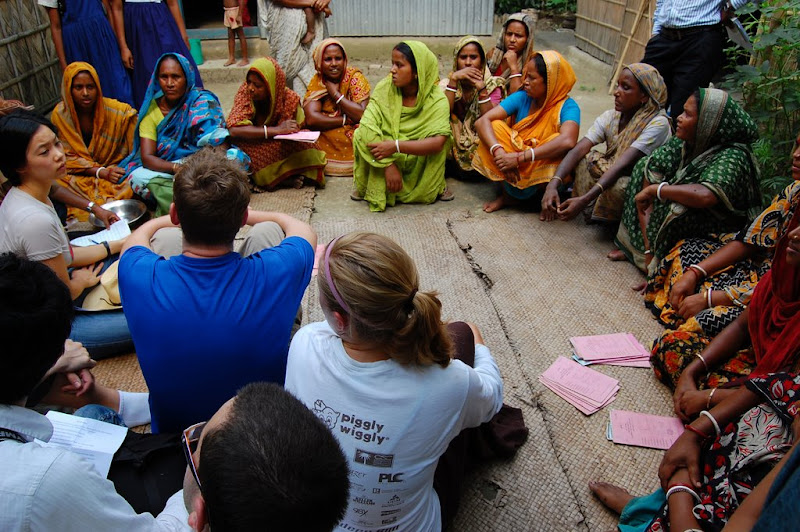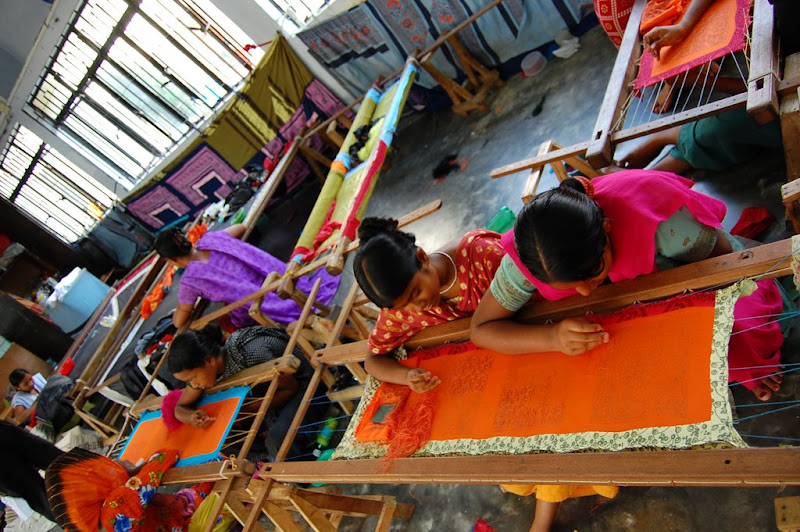Today we are visiting the BRAC Regional Office in Manikganj to understand BRAC’s expansive scope of operations, meet their Village Organization (VO) members and partake in their clients’ various assemblies. Our day was truly jam-packed with activities!
BRAC’s 1st Tier (Dabi) Microfinance Program
Our first stop during Wednesday's excursion into the field gave us an opportunity to observe BRAC's 1st tier (DABI) Microfinance Programme activities, as we sat in on a weekly Village Organization meeting. This was our first exposure to rural
With the sun beating down on us, it was a welcome relief when the group leader proudly invited us into her house (built with the profits she generated from BRAC loans). She excitedly approached us individually inside, motioning for us to sit down on her furniture, and introducing us to her sewing machine and, impressively, to her personal computer. We only spent half an hour in the village, but we left stunned and longing to see more.
- Rob
BRAC’s Health Program
In a single file line we slowly squeezed into the next compound followed by a trail of curious wide-eyed children, one of whom quickly snapped our photo with his camera phone. Quite the role reversal. We watched as the local health volunteered demonstrated and explained the importance of using soap when hand washing. Next, she chose a reluctant volunteer from the group of women, gave her an eye exam, and promptly handed her glasses for a near sighted prescription. It was so brief and to the point that we were stunned it was real. Next we were introduced to two men from the village with TB and then Puspita explained the Directly Observed Therapy program in which they would receive free meds. Lastly in our health program visit, we crammed into a one room prenatal clinic where we met a woman who was 7 months pregnant and saw the kits that the women could take with them if they wanted their pregnancy to happen at home. A little package of gauze, string, scissors, sanitary wipes, gloves and voila! – it's a do-it-yourself at home pregnancy kit!
- Michela
We visited a local BRAC elementary school and Puspita explained both the curriculum and how these schools compare to the other schools in the community and the country. The children preformed a local dance for us, which was simply amazing. All of the children also went through what they were hoping to be when they were older and most of the answers were “doctor” or “army”. Khorshid (one of student/translator/friends) explained to us that the army is one of the most respected professions in the country. One little boy said that he wanted to be a singer and was brave enough to sing a song for us.
The students also had artwork around the room, which was infinitely better than mine was when I was younger. One of the things I also noticed was the caliber of their English was very impressive.
- Sam
Human Rights and Legal Education Class
We then went to the Human Rights seminar, held in a small leafy courtyard in a remote village near Mikanjang. There were about twenty women sitting in a circle, learning about their rights as women and the legal systems in which they live. The seminar lasts for two weeks, and costs 15 Taka to establish sufficient buy-in from the women—though BRAC doesn’t need their money, they want the women to feel like they must get something out of their time. The seminar went over ten different rights schemes, from Islamic law to Bangladeshi land reforms. In the middle of the week, the top three students from each group form a Human Rights Committee, which helps women in the months and years ahead with their problems. If the Committee cannot solve an issue, it gets forwarded onto BRAC’s legal team in
Though the Human Rights seminar was not the cutest, or the most interesting, or the most exciting stop of the day, it was certainly one of the most important and impactful. Human Rights is the basis for all equality, and no matter how many technological or financial improvements BRAC can help produce, they cannot be shared by everyone if gender or race-based inequality exists. The Human Rights programme is immensely successful across
We were all so fortunate to observe part of the program in action, and many of us look forward to working with the Human Rights division in our future fieldwork.
- Adam
BRAC Community Library
A brightly painted mural announced our arrival at the community library, a cozy building sharing a grassy field with a lively school. As we passed by the classrooms, the children and teachers crowded around the doorway, curiously gazing with shy smiles. Tourists are not too common in
- Heather
Meeting with a 3rd Tier (Progoti) Microfinance Program Borrower
On our trip through Manikganj, we met a man who had qualified for the third stage of BRAC’s microfinance program, the stage that grants loans for micro-enterprises. He has taken out two loans thus far in order to purchase materials for his cloth distribution enterprise, which sells its product to people who use it to make saris. He has four employees working at his store at all times and has somewhere between 20-40 customers on a typical day. However, the bulk of his business comes during wedding seasons and before festivals, a time when cloth is in high demand. He acknowledges that his industry is very competitive, but his love for the field motivates him to run his store even amidst the competition. BRAC is the only institution that he has considered approaching for loans because of the convenience of being able to pay a fixed rate to an organization that comes to him. He has been so successful that a relative has opened up a similar shop right next door to him, giving him more competition that he welcomes.
- Eric
Aarong Handicrafts Production Centre
Back home, when I go shopping and buy clothes, I never think about where the clothes come from—just that they’re there, and they look good on me. As we walked through the Aarong Handicrafts Production Centre, the whole process of making a whole outfit that everyone here wears daily was incredible. We saw plain white sheets of cotton and silk be transformed into colorful tie-dyed cloth, stamped with complex patterns, and even embroidered with shiny beads. The beautiful dresses, robes, and scarves that come out of the Center are perfect in their beauty and variety—the look effortless in their perfection. Yet behind the scenes, the construction of these garments is hardly effortless. I saw the work that went behind each piece of work. I saw young girls carefully painting hot wax on to the cloth in the humid weather; I saw women repeatedly stamping and arranging patterns on to the cloth. There were many that washed the cloth by a pond in brilliant dyes then hung them in the wind to dry.
There were even others who spent tedious time sewing on hundreds of microscopic beads into the cloth, and yet others who gather in groups and sew the cloth together into garments by a window. Lastly, the garments go through an intense inspection—the quality control picks out the garments that would not be fit for sale—the mistakes are so little that Pushpita told us she would pay us if we could find the mistakes. These beautiful garments are a living for some—their life is spent to make these garments as beautiful and effortless as they seem.
- Anne
Sanitary Napkin Production Centre [BRAC
Naturally, being a man, I have been given the task of discussing our visit to the production center where “sanitation napkins” are made. While possibly being on the schedule to appease our fatigued minds (which by this point were nearing the level of a ten year-old’s), it was during this visit where we were once again shown the ingenuity of BRAC when it comes to improving the health conditions of the Bangladeshi people.
Upon arriving into the production center, it would appear that you were walking into some sort of operating room. Four women wearing surgical masks, wielding scalpel-like cutting tools, and shredding apart cotton are hunched over their work, making every effort to maintain the sterile environment necessary to ensure that the napkins are safe. As we moved down the open corridor, we became witness to the room that contained the sewing machines, where the cotton cloths are attached together and also where the rings were added, which allow the wearer to attach the cloth under their garments and wear the napkins comfortably. Lastly on our walk through, we were shown the room where the sanitation napkins are packaged. These packages, as we were told, will be sold cheaply all across the country so that they are affordable to even some of BRAC’s poorest members.
While this all sounded well and good, I must admit that during the tour, I did not fully understand why BRAC, a leader in microfinance, would bother producing makeshift tampons. This was until the end of the tour when our guide, Buspita, explained how these napkins are a part of BRAC’s mission to empower women. By distributing these sanitation napkins, the lives of these women are incredibly improved. After our visit, I became even more amazed by BRAC’s commitment to its people. Similarly to the eye tests and the demonstration on why people should wash their hands with soap, BRAC is making it incredibly easy for the people of
- John
Nursery [BRAC
A large part of the village organization meetings is the reciting of the 18 promises. These affirmations range from themes of health and cleanliness to protecting and proliferating social rights. Today behind the sanitary napkin factory we explored an expansion of promise number 9 that "We will grow vegetables and plant trees in and around our houses." In this case we visited a full nursery that seeded and grew plants and fruits. This was yet another enjoyed exposure to BRACs diverse, comprehensive and creative approaches to development. We enjoyed the trip. Speaking of which, we were stricken with falling while we were there. First, Rob tripped on a rock and dove headlong into a mud puddle. Thinking quickly Sam decided to mock him by going hypoglycemic and fainting into a garden pot. Shana dove for him as well and we all had a great time. Everyone is safe now and we learned a good lesson about staying hydrated and salted.
- Scott




No comments:
Post a Comment